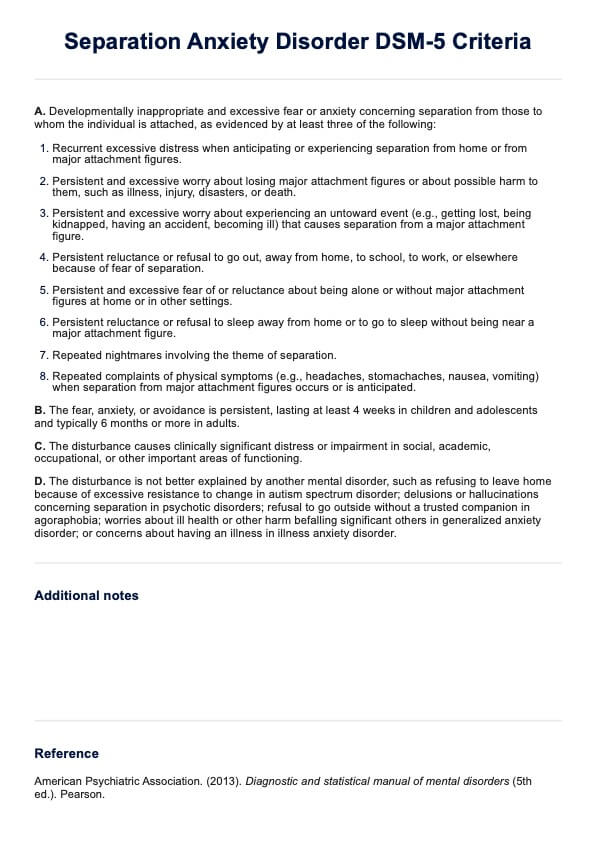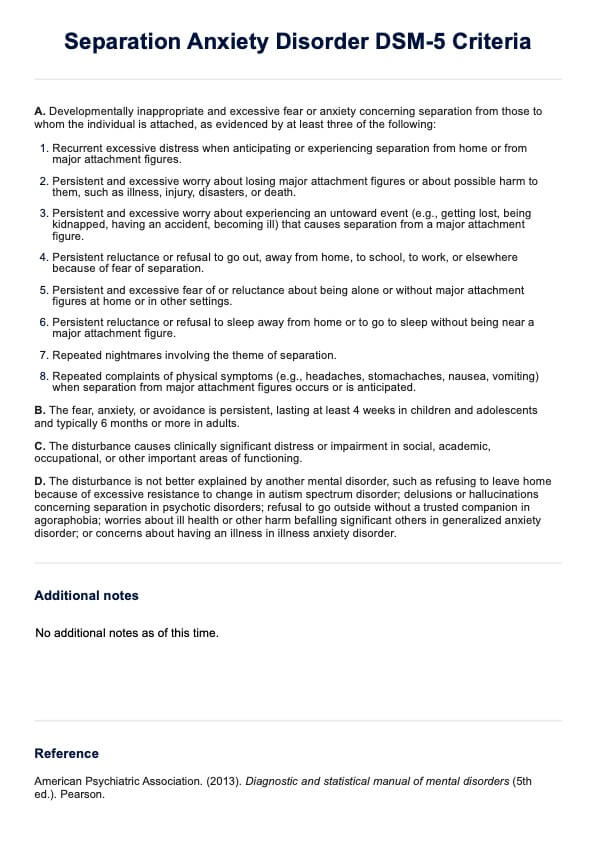Separation Anxiety Disorder DSM-5 Criteria
Download a free Separation Anxiety Disorder DSM-5 Criteria for more information and guidance.


What is separation anxiety disorder?
Separation anxiety disorder is characterized by excessive fear or anxiety concerning separation from major attachment figures. According to the Diagnostic and Statistical Manual of Mental Disorders (DSM-5), it falls under the category of anxiety disorders. Individuals with this disorder often experience persistent and excessive worry that something bad will happen to their loved ones or themselves when they are apart. This anxiety leads to persistent reluctance or refusal to be separated from major attachment figures, such as adult separation anxiety disorder.
Symptoms of separation anxiety disorder include clinically significant distress or persistent reluctance or refusal when separation occurs or is anticipated. These symptoms can manifest as physical complaints like headaches or stomachaches. Persistent and excessive worry are clinically significant, causing distress that disrupts daily life and social activities.
Separation anxiety disorder can occur in children as well as adults. In adults, it may manifest differently, often alongside other anxiety disorders such as panic disorder or generalized anxiety disorder. Treatment typically involves psychotherapy, including cognitive-behavioral therapy (CBT), aimed at reducing anxiety and improving coping strategies.
Separation Anxiety Disorder DSM-5 Criteria Template
Separation Anxiety Disorder DSM-5 Criteria Example
How is separation anxiety disorder diagnosed?
Diagnosing separation anxiety disorder involves a thorough assessment and evaluation process. Medical professionals follow specific criteria outlined in the Diagnostic and Statistical Manual of Mental Disorders (DSM-5). Here are the steps typically involved in diagnosing this disorder:
Clinical interview and assessment
The initial step in diagnosing separation anxiety disorder is conducting a comprehensive clinical interview. This involves gathering detailed information about the patient's symptoms (persistent and excessive worry), medical history, and any familial or environmental factors that may contribute to when the major attachment figures occur or are anticipated.
Symptom evaluation
Medical professionals evaluate the patient's symptoms based on DSM-5 criteria. These include recurrent excessive distress when separation occurs or is anticipated, persistent reluctance or refusal to leave home or go to school due to fear of separation, and excessive worry about losing major attachment figures.
Differential diagnosis
It's essential to differentiate separation anxiety disorder from other mental disorders that may present with similar symptoms, such as social anxiety disorder, generalized anxiety disorder, and adjustment disorders, or others that exhibit other types of anxiety, like illness anxiety disorder. This step ensures an accurate diagnosis and appropriate treatment plan.
Separation anxiety disorder DSM-5 diagnosis criteria
Separation anxiety disorder is now categorized under anxiety disorders. The DSM-5 criteria emphasize the following diagnostic criteria for separation anxiety disorder:
A. Developmentally inappropriate and excessive fear or anxiety concerning separation from those to whom the individual is attached, as evidenced by at least three of the following:
- Recurrent excessive distress when anticipating or experiencing separation from home or from major attachment figures.
- Persistent and excessive worry about losing major attachment figures or about possible harm to them, such as illness, injury, disasters, or death.
- Persistent and excessive worry about experiencing an untoward event (e.g., getting lost, being kidnapped, having an accident, becoming ill) that causes separation from a major attachment figure.
- Persistent reluctance or refusal to go out, away from home, to school, to work, or elsewhere because of fear of separation.
- Persistent and excessive fear of or reluctance about being alone or without major attachment figures at home or in other settings.
- Persistent reluctance or refusal to sleep away from home or to go to sleep without being near a major attachment figure.
- Repeated nightmares involving the theme of separation.
- Repeated complaints of physical symptoms (e.g., headaches, stomachaches, nausea, vomiting) when separation from major attachment figures occurs or is anticipated.
B. The fear, anxiety, or avoidance is persistent, lasting at least 4 weeks in children and adolescents and typically 6 months or more in adults.
C. The disturbance causes clinically significant distress or impairment in social, academic, occupational, or other important areas of functioning.
D. The disturbance is not better explained by another mental disorder, such as refusing to leave home because of excessive resistance to change in autism spectrum disorder; delusions or hallucinations concerning separation in psychotic disorders; refusal to go outside without a trusted companion in agoraphobia; worries about ill health or other harm befalling significant others in generalized anxiety disorder; or concerns about having an illness in illness anxiety disorder.
Differences between the DSM-IV and DSM-5 criteria
The differences include:
- Separation anxiety disorder was categorized under "disorders usually first diagnosed in infancy, Childhood, or adolescence" in the DSM-IV and now under anxiety disorders in the DSM-5.
- DSM-5 includes the expression of separation anxiety symptoms in adulthood.
- DSM-5 specifies that symptoms must persist typically for six months or more in adults.
- DSM-5 dropped the age criterion (onset before age 18) present in DSM-IV.
How is separation anxiety disorder treated?
Effective treatment for separation anxiety disorder typically involves a combination of therapy, medication, or a mix of both, tailored to the individual's symptoms and severity.
Therapy
Therapy, particularly Cognitive Behavioral Therapy (CBT), is a cornerstone in treating separation anxiety disorder. CBT helps individuals identify and challenge anxious thoughts and behaviors associated with separation from major attachment figures. Techniques such as gradual exposure to separation situations and relaxation training are commonly used to reduce anxiety symptoms. Family therapy may also be beneficial, involving parents and caregivers to support the individual's progress.
Medication
In cases where symptoms are severe or do not respond sufficiently to therapy alone, medications such as selective serotonin reuptake inhibitors (SSRIs) may be prescribed. SSRIs help regulate serotonin levels in the brain, which can alleviate anxiety symptoms. Medication is often used in conjunction with therapy to enhance treatment outcomes and manage persistent anxiety.
Mix of therapy and medication
A combination approach of therapy and medication is frequently recommended for individuals with severe separation anxiety disorder or those experiencing significant impairment in daily functioning. This approach addresses both the psychological aspects of anxiety through therapy and the biological factors through medication, providing comprehensive treatment and support.
Commonly asked questions
The DSM-5 criteria for separation anxiety disorder include recurrent excessive distress when anticipating or experiencing separation from major attachment figures, persistent worry about harm befalling attachment figures, reluctance to leave home due to separation fears, and symptoms lasting at least four weeks in children and typically six months in adults.
Separation anxiety disorder is diagnosed through clinical interviews, symptom evaluation based on DSM-5 criteria, differential diagnosis to rule out other disorders, physical examination, and collaboration with other healthcare professionals when necessary.
The ICD-10 code for separation anxiety disorder is F93.0.
There is an overlap between separation anxiety disorder and attention-deficit/hyperactivity disorder (ADHD) symptoms, but they are distinct disorders with separate diagnostic criteria. Some individuals may have both conditions concurrently, requiring careful assessment and management.




















-template.jpg)



















































































